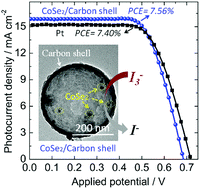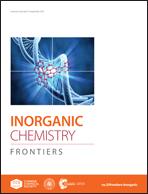CoSe2/porous carbon shell composites as high-performance catalysts toward tri-iodide reduction in dye-sensitized solar cells†
Abstract
Cost-effective, Pt-free catalysts possessing superior electrochemical activity and stability are highly desirable for triiodide reduction reaction in dye-sensitized solar cells (DSCs). Herein, CoSe2 nanoparticles embedded in porous carbon shells (CoSe2/CS) were explored as highly efficient catalysts toward triiodide reduction reaction. The CoSe2/CS composites were fabricated using a soft-template approach involving the carbonization and selenization processes. The CoSe2 nanoparticles were well distributed within highly graphitized nitrogen-doped carbon nanoshells. More importantly, the CoSe2/CS catalysts presented both high catalytic performance and long-term stability, outperforming those of the thermally-deposited Pt electrode. Furthermore, the optimized DSC device with a CoSe2/CS catalyst-based counter electrode showed a power conversion efficiency of 7.54%, exceeding that of the thermally-deposited Pt (7.40%) counterpart. The enhanced catalytic activity, long-term stability and photovoltaic efficiency can be attributed to the much more reaction sites provided by CoSe2 nanoparticles embedded within the porous carbon shells, as well as the better band matching with the potential of the I3−/I− redox couple, revealed by the Kelvin probe force microscope measurement. This work will provide a strategy to construct low-cost, highly efficient and stable non-Pt catalysts for photovoltaic applications.



 Please wait while we load your content...
Please wait while we load your content...